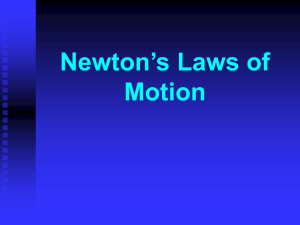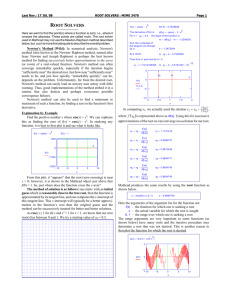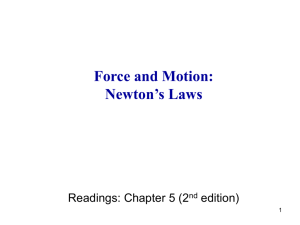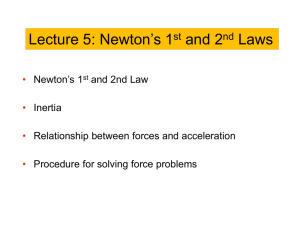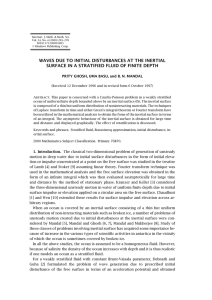force - Department of Mathematics - National University of Singapore
advertisement
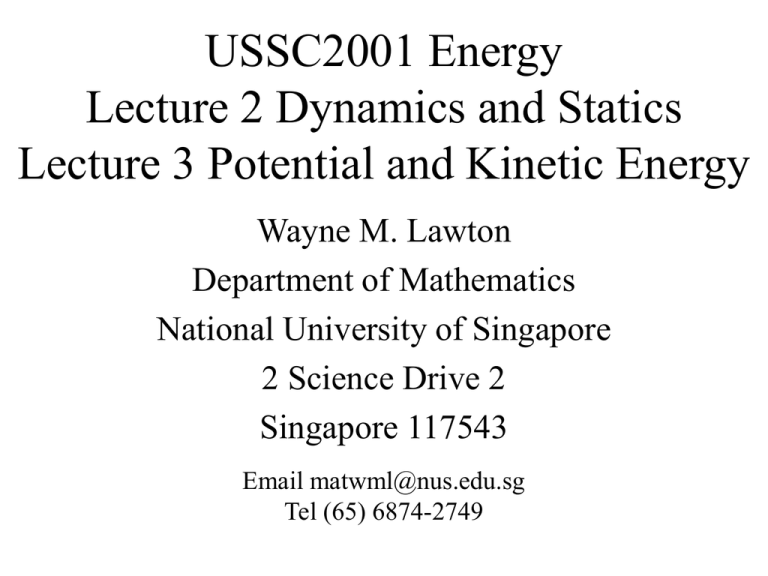
USSC2001 Energy Lecture 2 Dynamics and Statics Lecture 3 Potential and Kinetic Energy Wayne M. Lawton Department of Mathematics National University of Singapore 2 Science Drive 2 Singapore 117543 Email matwml@nus.edu.sg Tel (65) 6874-2749 CONTENTS These vufoils contain lectures 2&3 and tutorial 2. They use the Euclidean (synthetic) and analytic geometry of space/time developed in lecture 1 and tutorial 1 to describe Newton’s laws of motion and the energy concept. They are primarily concerned with physics as opposed to geometry. The concept that force was required to move an object originated before Sir Isaac Newton (1642-1727) [who, independently with Leibniz (1646-1716) invented The Calculus], however Newton quantified how an object moves under the influence of forces by proposing three laws of motion. NEWTON’S FIRST LAW If no force acts on a body, then the body’s velocity cannot change; that is, the body cannot accelerate. Note: force is a vector quantity – it has both magnitude and direction! What happens if two or more people pull on an object? This question leads to the following more precise statement If no net force acts on a body, then the body’s velocity cannot change; that is, the body cannot accelerate. STATICS Why is this object static (not moving) ? mg Hint: What are the forces acting on this object? What is the net force acting on this object? INERTIAL REFERENCE FRAMES Newton’s first law does not hold in all reference frames – however there are frames for which it holds and these frames are called inertial frames. Explain why a frame Fm that moves with constant velocity v with respect to an inertial frame Fi is also an inertial frame. Hint: what is the relative velocity with respect to the frame Fmof an object that has velocity w with respect to the frame Fi Question: Is the ground an approximate inertial frame? Suggest a better inertial frame. Are there perfect ones? MASS Imagine kicking a soccer ball and a similar sized stone (we recommend this as a virtual experiment!) what is the difference in their resulting velocities? The mass of an object is often called the inertial mass since the word inertia suggests resistance to change. This observation leads to the conjecture that the ratio of the masses of two objects is equal to the inverse of the ratio of their accelerations when the same force is applied. Questions: How we can take the ratio of these vectors? What happens if a different force is applied? What is the mass of an object formed by joining two objects? NEWTON’S SECOND LAW The net force on a body is equal to the product of the body’s mass and the acceleration of the body. Question: how are the net forces on a body along the horizontal and verticle directions related to the body’s acceleration? Question: what constant horizontal force must be applied to make the object below (sliding on a frictionless surface) stop in 2 seconds? v 6m / s SOME SPECIFIC FORCES Gravitational Force: direction, weight, near Earth’s surface and far away, Newton’s law, g and G Normal Force: surfaces, constraints, orthogonality Friction: direction, causes, why is heat generated Tension: direction TUTORIAL 2 1. Compute the direction of acceleration, normal force, net force, and acceleration of the object falling down an inclined frictionless plane shown below. How long does it take to fall from the top to the ground if the initial velocity equals zero? h θ NEWTON’S THIRD LAW When two bodies interact, the forces on the bodies from each other are always equal in magnitude and opposite in direction. Question: how can this fact be used to compute the ratio of the masses of two objects? Question: the momentum of a body is the product of its mass and velocity, the momentum of a system of bodies is the sum of their momenta, show that when a system of bodies interacts the momentum of the system is invariant. VECTOR ALGEBRA FOR STATICS The tension forces are Fl a cos θ a sin θ The gravity force is Fg Fr 0 mg b cos b sin VECTOR ALGEBRA FOR STATICS Since the object does not move, Newtons’s second law implies that the net force on the object equals zero 0 Fnet Fl Fr Fg 0 a cos b cos 0 0 Therefore hence a sin b sin mg 0 mg cos mg cos a ,b cos() sin( ) DEFINITIONS OF ENERGY [1] The American Heritage Dictionary of the English Language, Houghton Mifflin, Boston, 1992. 1 The capacity for work or vigorous activity, strength 2 Exertion of vigor or power ‘a project requiring a great deal of time and energy’ 3 Usable heat or power ‘Each year Americans consume a high percentage of the world’s energy’ 4 Physics. The capacity of a physical system to do work -attributive. energy – conservation, efficiency ENERGY-WORK-TOOL CONCEPT [1] Appendix: PIE http://www.bartleby.com/61/roots/IE577.html (old form 5.5-7ky) Werg – to do (suffixed form) Werg-o derivatives handiwork,boulevard,bulwark, energy, erg, ergative,-urgy; adrenergic,allergy,argon,cholinergic,demiurge, dramaturge,endergonic, endoergic,energy,ergograph,ergometer, ergonomics,exergonic,exergue, exoergic,georgic,hypergolic,lethargy,liturgy,metallurgy,surgery,synergids ynergism,thaumaturge,work Greek: ergon energos energeia Latin: energia French:energie Germanic: werkam Old High German: werc, Old English: weorc,werc (zero-grade form) Wig derivatives wrought, irk, wright (o-grade form) Worg derivatives organ, organon (= tool), orgy LIFTING AS WORK - BALANCE Lifting mass is a form of work. It requires energy. One source of this energy is to lower another mass. 3kg 1kg 1m arm or lever 3m frulcrum These ‘toys’ for children are examples of reversible machines – they can be used to lift and then lower the heavier weights using an arbitrarily small extra force that is sufficient to overcome the friction. LIFTING AS WORK - PULLEY In the balance shown below, the heavier/lighter mass may be lifted by lowering the lighter/heavier mass. 1m 2kg 1kg 2m Here, as in the balance, the objects move in opposite directions by distances that are inversely proportional to their masses ? TUTORIAL 2 2. Compute the mass of the object on the side of the block that has length 2m. ? kg 3kg 1m 2m GRAVITATIONAL POTENTIAL ENERGY Consider a set of objects numbered 1,2,…,N having weights and heights gm1 , gm 2 ,..., gm N y1, y 2 ,..., y N and initially at rest. If these objects interact so the total effect only changes their heights, then the weighted sum of heights i1 N remains gm i y i unchanged. The gravitational potential energy is conserved. ELASTIC POTENTIAL ENERGY Consider the reversible machine that uses a spring to lower a weight by sliding it to the left compressible spring Initially, the two weights are placed on each side of the fulcrum so as to balance the lever. What happens as either weight is moved to the left? Where did the gravitational potential energy go? WORK POTENTIAL ENERGY To do work on a static system (consisting of massive objects and springs), such as lifting objects or compressing springs, means to increase the net potential energy. This requires force. The work, which measures the increase in potential energy, is related to the force and distance (for one dimensional motion) by Work (energy ) x final x initial Force( x )dx ELASTIC ENERGY IN A SPRING The figure below illustrates a spring being compressed k = spring constant xi x xf Initial (Relaxed) State Compressed State Hook’s Law states that F( x ) k ( x x i ) hence xf E elast ic xi 2 k k ( x x i )dx ( x f x i ) 2 POTENTIAL AND KINETIC ENERGY Theorem: For a dropping weight, the total energy 2 1 mgy my is conserved (constant function of t) 2 1 2 my is called the kinetic energy. The quantity 2 Proof. Let E = E(t) denote the total energy. Then dE( t ) dt mgy myy 0 since y g and the fundamental theorem of calculus implies that E ( T ) E ( 0) t T dE( t ) t 0 dt dt E (0) TUTORIAL 2 3. Compute the required spring constant of a spring gun that is is to be compressed by 0.1m and capable of shooting a 0.002kg projectile to a height of 100m. Assume that the mass of the spring is zero and that no frictional forces are present. 4. Compute the energy required to compress 1 cubic meter of gas to one half of its original volume at constant temperature if the original pressure equals 101300N / square meter. Hint: use the fact that the pressure is inversely proportional to the volume (and therefore increases as the gas is compressed). HARMONIC OSCILLATIONS For an object attached to a spring that moves horizontally, the total 2 energy E 1 kx 2 1 mx x x 0 2 2 is conserved, therefore x ( t ) a cos ( t where is the amplitude a 2E k k m R 2 T is the angular frequency is the phase, and is the period. ) HARMONIC OSCILLATIONS Consider a pendulum - an object on a swinging lever. Then for small θ 2 2 Lm E gθ Lθ 2 θ θ( t ) a cos (t ) a 2E , Lmg g , L R L
